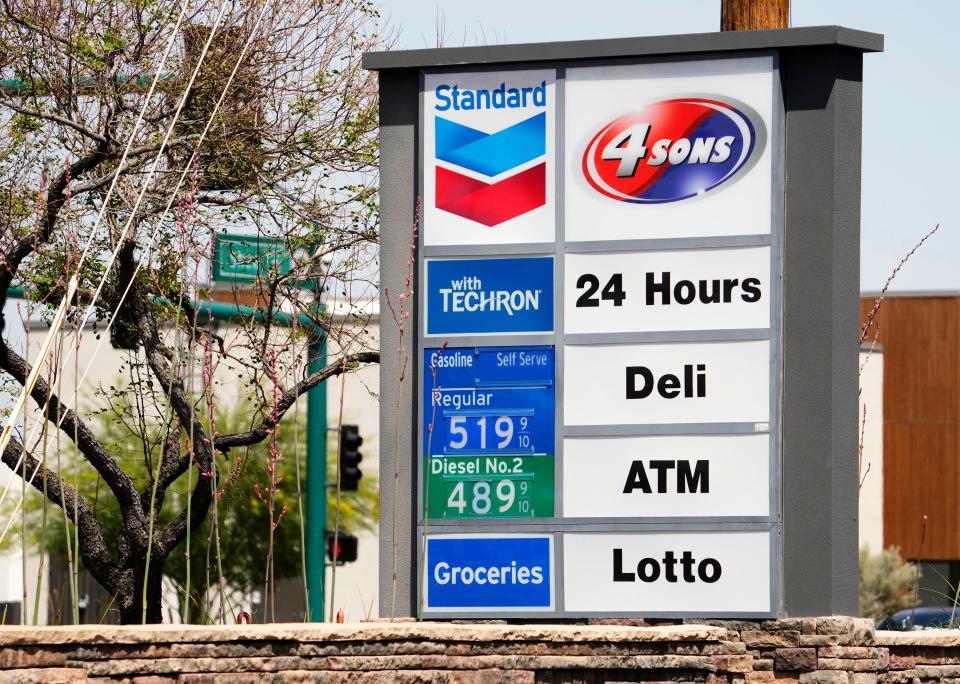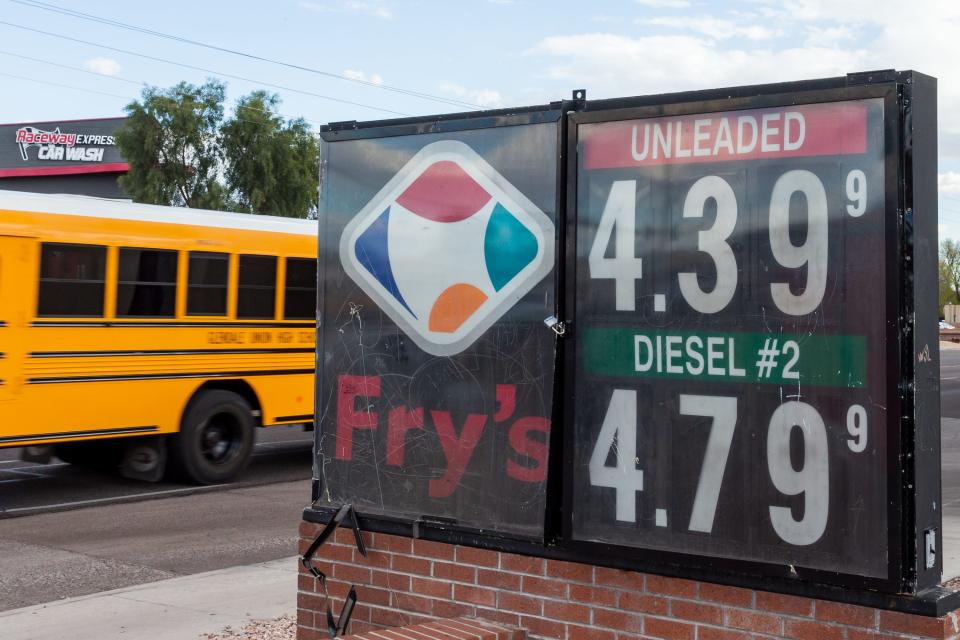Arizona gas prices see slight dip while national averages remain stalled
Average gas prices remained high this week in Arizona, but registered a slight decrease, while the national average remained stalled, according to AAA data released Thursday.
Arizona's state average for a gallon of gas remains a little over $1 than that of the national average, pumping in at $4.64 as of Thursday.
The national average for a gallon of gas remained stationary this week, holding at $3.53.
Experts, however, foresee "significant relief" just starting and continuing throughout the next weeks. Here's what we know about the state of oil prices today.
Why are gas prices so high?

Prices have stalled at that mark since last week with no reported dip, in large part due to a decline in demand as well as the low cost of oil, AAA said.
“Despite mild weather and a less volatile economic forecast, drivers are not hitting the road and raising gasoline demand to traditional seasonal levels,” AAA spokesperson Andrew Gross said in the release. “It’s possible this is merely the lull before Memorial Day, but it could be a trend that lingers into summer.”
Gas demand, according to new data from the Energy Information Administration cited by AAA, dropped from 9.30 to 8.91 million barrels per day last week, with total domestic gasoline stocks decreasing by 1.4 million barrels of crude oil to 218.3 million.
Wednesday's formal trading session close saw West Texas Intermediate increase by nearly $2, settling at $72.83.
"Oil prices rose yesterday amid growing market optimism that global energy demand is rebounding, particularly since China is recovering faster than originally expected following the lifting of its COVID restrictions. Additionally, the EIA reported that total domestic commercial crude inventories increased by 5 million bbl to 467.6 million bbl last week," AAA said.
More on gas prices: Arizona gas prices 'stabilized' while national average dips by 4 cents
'Unique challenges' cause delayed relief for Arizona
AAA data showed that Arizona had one of the largest changes in their average, decreasing by 4 cents since last Thursday, trailing only Florida where pump prices saw a 7-cent drop.
Any decline is a welcome one in terms of gas prices — especially in Arizona — one that Patrick De Haan, head of petroleum analysis at GasBuddy, believes is also coming.

"For those in Arizona that have seen gas prices spike during the spring, significant relief is starting and should even accelerate over the weeks ahead," De Haan said in a GasBuddy release Monday.
This relief could have been in step with the rest of the nation had it not been for a few factors.
"We've seen a lot of unique challenges. Arizona has its own blend of gasoline the state mandates, which are making the problems more acute in some areas. Some areas require clean burning gasoline, some don't, but they still have a different Arizona type of gas that's required," De Haan told the Republic.
Fragmentation, supply, a booming population, Arizona requirements and a slew of different blends are the main catalysts in De Haan's eyes for the Grand Canyon state's gas woes.
"When you have different blends being used in different areas across the state, that are only specific to your state — and when you have no refineries in your state — you rely on refineries in California and in El Paso and New Mexico to produce these special Arizona blends," De Haan said. "The problem is right now because of the population boom in Arizona, there's not enough pipeline capacity to bring in enough gasoline, at least all these different types of gasoline from California alone."
Across the United States, dozens of different summer blends are utilized throughout, something that adds a level of polarization to the conversation.
"People get confused enough when they hear summer versus winter, and they think all the summer gasoline is the same, but it's not. There are twelve different types depending on where you live. That's why Arizona is getting hit with this, but if a refinery in Chicago, which has its own blend of reformulated gas in the summer. If the refinery in northwest Indiana goes down that produces a lot of the Chicago gasoline, we've seen it. Prices went up a buck a gallon overnight. When things are operating fine nobody notices, nobody cares, but when things break this is what happens," said De Haan.
Additionally, refinery maintenance, while a continued theme, has contributed to the lack of plummeting pump prices.
"The pipeline that runs from Texas to New Mexico to Tucson and Phoenix, well the refineries that have feed ins to that pipeline have been doing maintenance and on the west the gasoline flowing in from California, the pipeline for a while has been at 100% capacity," De Haan said.
But by returning to a "commonality", however, and switching to, say, the same gas as maybe California, the problem could be better mitigated.
"If Arizona switched to the type of gasoline that California uses, you probably wouldn't see any of these prices spike because commonality, there's more supply in California, refineries there are producing it for California already, but Arizona opted out of the EPA's summer gasoline program and opted to go its own route - now it's paying the price," said De Haan.
As for now, high gas prices in Arizona are something that could potentially return every spring, according to De Haan.
"We saw it again this year, and we'll probably see it again next year unless Arizona politicians decide to get rid of the rules, that's a lot of why we're seeing this," De Haan said. "It's unfortunate and so where there aren't a lot of restrictions on gasoline the prices are much lower because supply is much higher. When you localize rule for such a specific area for only certain times of the year, it becomes a logistical nightmare to supply fuel into that market. Nobody wants to be stuck with Arizona barrels because guess what, they can't sell them anywhere else," De Haan said.
County-by-county gas prices in Arizona
As of May 18, Maricopa still takes the cake as the most expensive county in the state for a gallon of gas at $4.98.
Graham County returns as the least expensive, coming in at a cool $3.40.
The rest of Arizona chalks up like this:
Maricopa: $4.98
Pima: $4.66
Pinal: $4.52
Santa Cruz: $4.38
Coconino: $4.35
Yavapai: $4.25
La Paz: $4.15
Navajo: $4.06
Gila: $4.04
Mohave: $4.02
Apache: $3.97
Yuma: $3.94
Greenlee: $3.90
Cochise: $3.87
Graham: $3.40
This article originally appeared on Arizona Republic: Arizona gas prices see slight dip while national averages remain stalled

